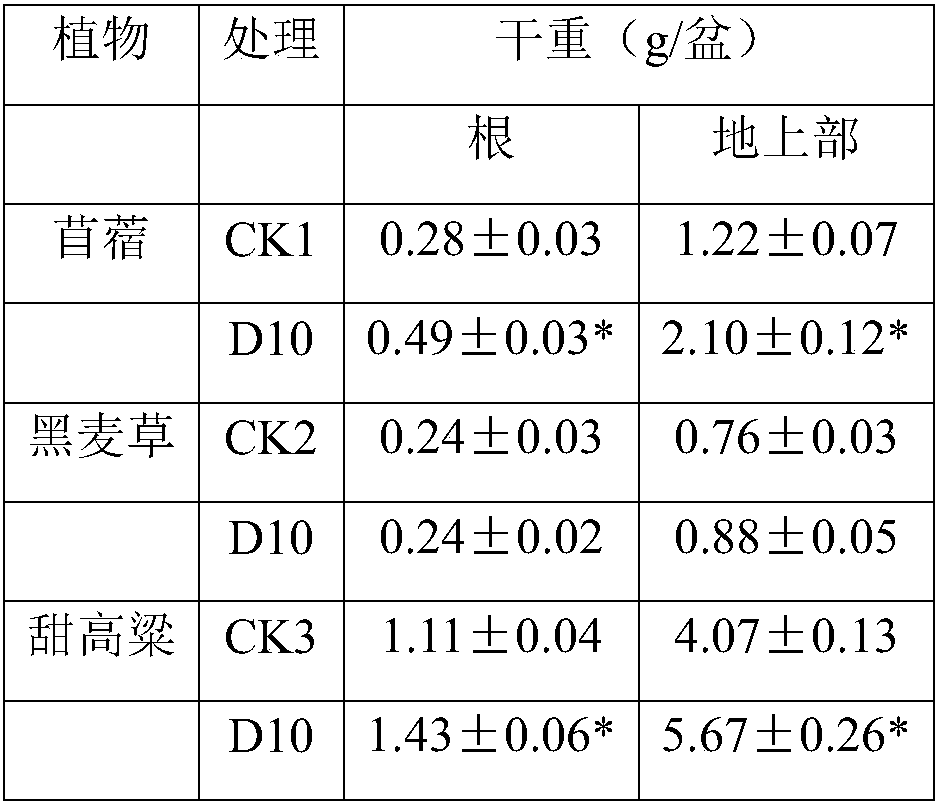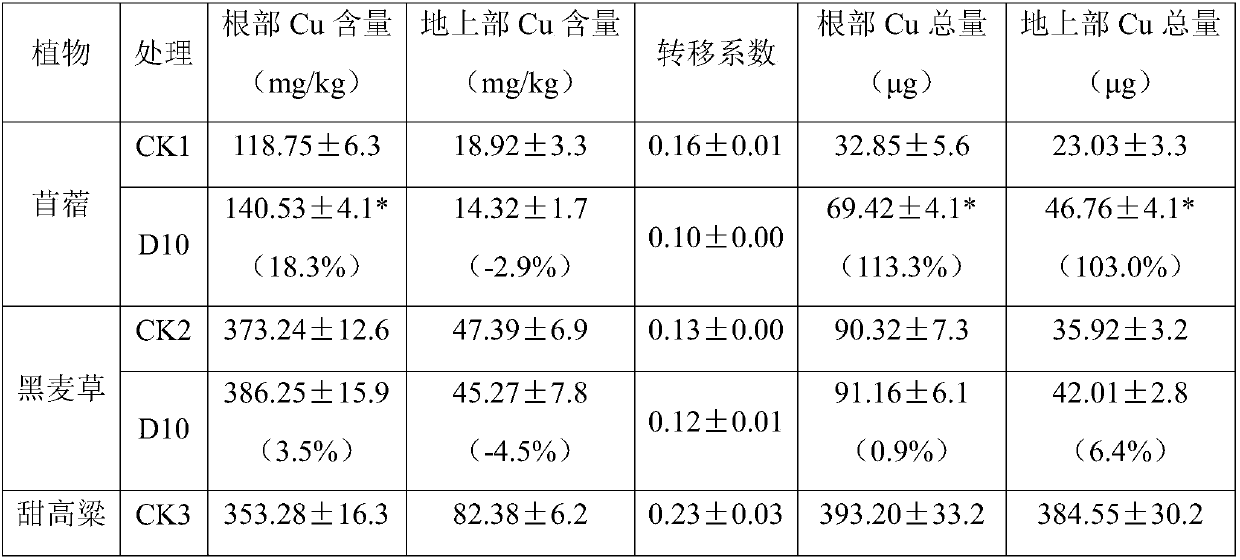Bacterium D10 for improving validity of heavy metal and application of bacterium D10
A heavy metal, effective technology, applied in the fields of agricultural technology and environmental pollution control, can solve the problem of small biomass, achieve the effect of promoting plant growth and increasing the content of heavy metals in plants
- Summary
- Abstract
- Description
- Claims
- Application Information
AI Technical Summary
Problems solved by technology
Method used
Image
Examples
Embodiment 1
[0038] The heavy metal-resistant plant growth-promoting bacteria D10 strain of the present invention is isolated and purified from alfalfa (Medicogo sativa L.) root nodules grown in heavy metal-contaminated soil, and the isolation and identification method is as follows:
[0039] Gently pull the alfalfa out of the soil, shake off the loose soil from the roots and rinse with water. Select the plump and large-diameter pink nodules on the main root, and cut them off with scissors. Soak the cut root nodules in deionized water for 4-5 minutes to remove residual impurities, soak them in 75% ethanol for 2-3 minutes, wash them with water for 2-3 times, soak them in 3% NaClO solution for 5 minutes, and finally wash them with sterile deionized water Wash with water 5-7 times. Under aseptic conditions, put the surface-sterilized nodules on a YMA solid plate containing 0.3% Congo red [mannitol 10.0g, yeast powder 1.0g, MgSO 4 ·7H 2 O 0.2g, K 2 HPO 4 0.5g, NaCl 0.1g, anhydrous CaCl ...
Embodiment 2
[0041] Activation of embodiment 2 bacterial strain D10 and bacterial suspension preparation
[0042] Inoculate D10 (CCTCC NO: M 2016554) slant bacteria into TY solid medium (tryptone 5.0g, yeast extract 3.0g, CaCl 2 0.3g, 20g agar, 1000ml distilled water, pH 7.0), cultured at 30°C for 3d. Then select plump, viscous D10 colonies and inoculate them in TY liquid medium (tryptone 5.0g, yeast extract 3.0g, CaCl 2 0.3g, distilled water 1000ml, pH7.0), 30°C 150rpm shaking culture for 20-24h, so that the number of cells can reach more than 500 million CFU / ml.
Embodiment 3
[0043] The ability of embodiment 3 bacterial strain D10 to produce IAA
[0044] According to the determination method of Gordon and Weber (1951), TY liquid medium was divided into test tubes, 4 mL per tube, and 1 mL of 2.5 mg / mL tryptophan solution sterilized by filtration was added after high-temperature sterilization at 121 ° C to make the color in the medium The final concentration of amino acid was 0.5 mg / mL. D10 (CCTCC NO: M 2016554) was inoculated in the above medium, and cultured in a shaker at 30°C for 3 days. The fermentation broth was centrifuged at 12000r / min for 5min, 1mL of the supernatant was taken, 50μL of 10mM orthophosphoric acid was added, and 2mL of Sackowski's chromogenic reagent was added, mixed thoroughly, the color was developed at 25°C for 30min in the dark, and the absorbance value was measured at a wavelength of 530nm. The sterile medium was treated the same as above and set to zero as a control. Use the IAA standard solutions with concentrations of...
PUM
 Login to View More
Login to View More Abstract
Description
Claims
Application Information
 Login to View More
Login to View More - R&D
- Intellectual Property
- Life Sciences
- Materials
- Tech Scout
- Unparalleled Data Quality
- Higher Quality Content
- 60% Fewer Hallucinations
Browse by: Latest US Patents, China's latest patents, Technical Efficacy Thesaurus, Application Domain, Technology Topic, Popular Technical Reports.
© 2025 PatSnap. All rights reserved.Legal|Privacy policy|Modern Slavery Act Transparency Statement|Sitemap|About US| Contact US: help@patsnap.com



